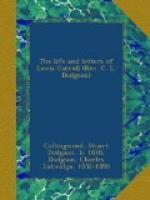This acquaintance ripened into a true, artistic friendship, which lasted till Mr. Dodgson’s death. In his first letter to Miss Thomson he speaks of himself as one who for twenty years had found his one amusement in photographing from life—especially photographing children; he also said that he had made attempts ("most unsuccessfully”) at drawing them. When he got to know her more intimately, he asked her to criticise his work, and when she wrote expressing her willingness to do so, he sent her a pile of sketch-books, through which she went most carefully, marking the mistakes, and criticising, wherever criticism seemed to be necessary.
After this he might often have been seen in her studio, lying flat on his face, and drawing some child-model who had been engaged for his especial benefit. “I love the effort to draw,” he wrote in one of his letters to her, “but I utterly fail to please even my own eye—tho’ now and then I seem to get somewhere near a right line or two, when I have a live child to draw from. But I have no time left now for such things. In the next life, I do hope we shall not only see lovely forms, such as this world does not contain, but also be able to draw them.”
But while he fully recognised the limits of his powers, he had great faith in his own critical judgment; and with good reason, for his perception of the beautiful in contour and attitude and grouping was almost unerring. All the drawings which Miss Thomson made for his “Three Sunsets” were submitted to his criticism, which descended to the smallest details. He concludes a letter to her, which contained the most elaborate and minute suggestions for the improvement of one of these pictures, with the following words: “I make all these suggestions with diffidence, feeling that I have really no right at all, as an amateur, to criticise the work of a real artist.”
The following extract from another letter to Miss Thomson shows that seeking after perfection, that discontent with everything short of the best, which was so marked a feature of his character. She had sent him two drawings of the head of some child-friend of his:—
Your note is a puzzle—you say that “No. 2 would have been still more like if the paper had been exactly the same shade—but I’d no more at hand of the darker colour.” Had I given you the impression that I was in a hurry, and was willing to have No. 2 less good than it might be made, so long as I could have it quick? If I did, I’m very sorry: I never meant to say a word like it: and, if you had written “I could make it still more like, on darker paper; but I’ve no more at hand. How long can you wait for me to get some?” I should have replied, “Six weeks, or six months, if you prefer it!”
I have already spoken of his love of nature, as opposed to the admiration for the morbid and abnormal.




